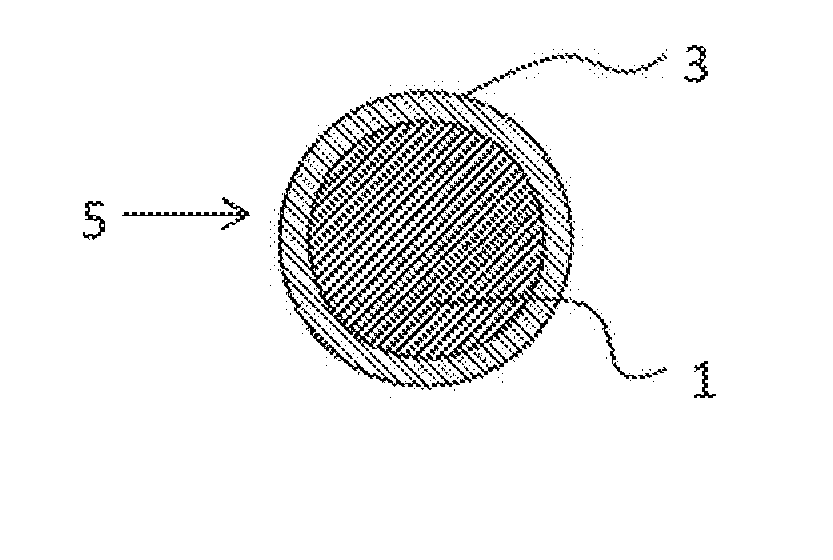Charging member, method of producing the same, process cartridge, and electrophotographic apparatus
a charging member and electrophotography technology, applied in the direction of corona discharge, coatings, instruments, etc., can solve the problems of high protrusion, easy accumulation of smear, and difficulty in generating discharge from high protrusion, and achieve stable charging performance, high conductivity, and easy generation
- Summary
- Abstract
- Description
- Claims
- Application Information
AI Technical Summary
Benefits of technology
Problems solved by technology
Method used
Image
Examples
examples
[0175]Hereinafter, the present invention will be described more in details using Examples.
[0176]First, before Examples, methods of measuring a variety of parameters in the present invention, Production Examples A1 to A26 of the resin particle, and Production Examples B1 and B2 of the electro-conductive fine particle and insulation particle will be described. In the particles below, the “average particle diameter” means the “volume average particle diameter” unless otherwise specified.
1. Methods of Measuring a Variety of Parameters
[0177][1] Resin Particle as Raw Material Used in Formation of the Surface Layer (Porous Resin Particle and Other Resin Particles).
[0178][1-1. Measurement of Stereoscopic Shape of Resin Particle as Raw Material]
[0179]The resin particle as the raw material (primary particle) is cut by 20 nm with a focused ion beam machining observation apparatus (trade name: FB-200C, made by Hitachi, Ltd.), and the image of the cross section is photographed. In the same resin...
production example a1
[0210]Production of Resin Particle A1
[0211]8.0 parts by mass of tricalcium phosphate was added to 400 parts by mass of deionized water to prepare an aqueous medium. 32.0 parts by mass of methyl methacrylate, 21.9 parts by mass of ethylene glycol dimethacrylate, 23.6 parts by mass of normal hexane, 12 parts by mass of ethyl acetate, and 0.3 parts by mass of 2,2′-azobisisobutyronitrile were mixed to prepare an oily mixed solution. The oily mixed solution was dispersed in the aqueous medium with a homomixer at the number of rotation of 3600 rpm. Subsequently, a polymerization reaction container was replaced with nitrogen, and the solution was charged into the container. While the solution was being stirred at 250 rpm, the solution was suspension polymerized at 60° C. over 6 hours to obtain an aqueous suspension of the porous resin particle including normal hexane and ethyl acetate.
[0212]0.4 parts by mass of sodium dodecylbenzenesulfonate was added to the obtained aqueous suspension, an...
production examples a2
to A23
Production of Porous Resin Particles A2 to A23
[0213]Porous resin particles A2 to A23 were obtained in the same manner as in Production Example A1 except that the kinds and amounts of the polymerizable monomer, the crosslinkable monomer, the first porosifying agent, and the second porosifying agent to be used and the number of rotation of the homomixer were changed as shown in Table 1.
PUM
| Property | Measurement | Unit |
|---|---|---|
| volume average particle diameter | aaaaa | aaaaa |
| thickness | aaaaa | aaaaa |
| particle diameter | aaaaa | aaaaa |
Abstract
Description
Claims
Application Information
 Login to View More
Login to View More - R&D
- Intellectual Property
- Life Sciences
- Materials
- Tech Scout
- Unparalleled Data Quality
- Higher Quality Content
- 60% Fewer Hallucinations
Browse by: Latest US Patents, China's latest patents, Technical Efficacy Thesaurus, Application Domain, Technology Topic, Popular Technical Reports.
© 2025 PatSnap. All rights reserved.Legal|Privacy policy|Modern Slavery Act Transparency Statement|Sitemap|About US| Contact US: help@patsnap.com



